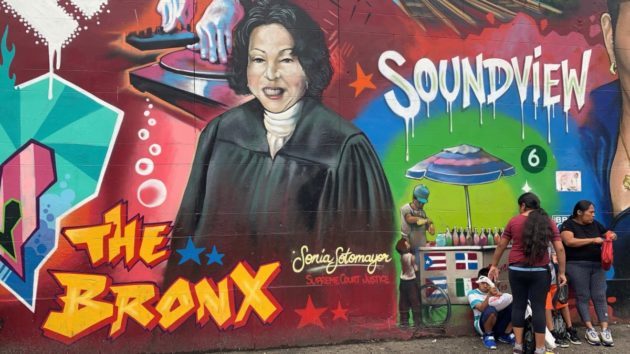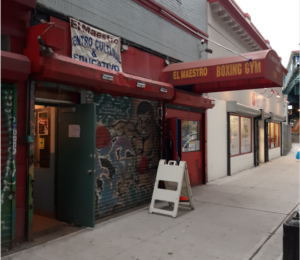
Like many Bronx Puerto Ricans, Nando Hernandez is worried about a new birth certificate law that could affect his mother, Maria. Photo: Yardena Schwartz
Maria Delia Hernandez suffers from failing kidneys, gout, high blood pressure, asthma and a chronic liver disease. In her apartment on the Grand Concourse, the 75-year-old lies in bed hooked up to the dialysis machine she depends on to do her kidneys’ work.
But Hernandez worries more about her latest ailment: the invalidation of her legal status in the United States.
Hernandez is joined in this predicament by more than 105,000 other native Puerto Ricans in the Bronx.
On Thursday, Sept. 30, all birth certificates issued by Puerto Rico before July 1 will become null and void. The Puerto Rican government announced the new law in December 2009, in collaboration with the U.S. State Department and Department of Homeland Security, to curb massive fraud and theft of Puerto Rican birth certificates.
Home to almost half of all island-born Puerto Ricans in New York City, the Bronx boasts one of the highest concentrations of Puerto Ricans outside of the island, according to the Department of City Planning.
A birth certificate from Puerto Rico is valuable property for Hispanic immigrants seeking a quick path to U.S. citizenship, and until now it has been quite easy to get.
Puerto Rico was unique in the way its birth certificates were used in the past, said Sarah Echols, spokeswoman for the Puerto Rico Federal Affairs Administration. “Parents signing their kids up for school, Little League, church camps, anything part of daily life, had to turn over an original birth certificate,” said Echols. “I’ve heard stories where 10 to 12 original copies of one person’s birth certificate were floating around different organizations.”
This practice left certified original birth certificates sitting in largely unsecured offices, and criminals took advantage.
“There were cases of fraud rings breaking into schools, finding the files, and taking the birth certificates out to sell them on the black market,” Echols said.
According to federal officials, Puerto Rican birth certificates were selling illegally for up to $10,000 a piece. The U.S. State Department discovered that 40 percent of the 8,000 cases of passport fraud it investigated were tied to Puerto Rican birth certificates.
The new law aims to combat fraud not only by requiring people to apply for the new birth certificate, which means those stolen birth certificates will no longer be valid; it also mandates that no agency can retain a copy of a person’s original birth certificate. People may have to show the document, or provide a photocopy, but the law prohibits anyone from having to hand over an original copy of his or her birth certificate for any reason.
But for elderly Puerto Ricans like Hernandez and others who no longer have the documents they need to comply, the law has become troubling.
Lisa Velez, 44, of Mott Haven, is still trying to figure out how her 65-year-old mother will get her new birth certificate. Her mother, Elba Caraballo can’t find her old birth certificate, and has never had a driver’s license or passport.
Velez didn’t know her mother needed a new birth certificate until the New York City Housing Authority asked for it in order to re-certify her public housing benefits. Velez is afraid her sick mother, who rarely leaves her apartment because of anxiety, will have to go to Puerto Rico in order to prove her citizenship there.
“I really don’t want her traveling, and I don’t do planes,” ” said Velez. “Not after 9/11.”
Critics say that many Puerto Ricans on the mainland, as they refer to the United States, have never heard about the law.
“The Puerto Rican government hasn’t done enough to communicate it to the Puerto Rican community here, so most of them know nothing about it,” said Ana Maldonado, chief operating officer at Promesa, a community development group that works with Puerto Ricans in the Bronx.
Hernandez found out about the law when she was contacted by a city housing representative, and she’s been in a panic ever since. She hasn’t seen her birth certificate in 10 years, and has forgotten her birth date and hometown, information she needs in order to apply for the new certificate.
Representatives of the Puerto Rican government insist they have done everything in their power to inform their citizens in New York about the new law.
“News reports are a result of our outreach,” said Luis Balzac, who heads the Puerto Rico Federal Affairs Administration in New York. “We’ve done seminars, presentations, group meetings with nonprofits and elected officials to make sure the Puerto Rican community is aware of the benefits of this law.”
Originally the law stated that old birth certificates would become invalid on July 1, the same day people could start applying for the new one. That would have allowed no time for people or government agencies to prepare for the mass invalidation of their documents. Bowing to pressure from Hispanic advocacy groups, the law was amended in late June, extending the deadline through the end of September.
Some say that still isn’t enough time. “We should have until December,” said Maldonado, “and that extension should be accompanied by an aggressive communications campaign.”
There could be serious consequences for those who don’t know about the law, or who have trouble obtaining the new document.
“Many native Puerto Ricans without the new birth certificate could be denied social services, health care, public schooling, jobs, drivers licenses and public housing benefits,” said Maldonado. In an economy where finding a job is hard enough, not having a valid birth certificate is yet another barrier to employment.
Hernandez is afraid that she could lose the right to her Section 8 apartment, which she’s been living in for two decades.
“They keep bothering us to get the new certificate, but we can’t,” said her son, Louis Figueroa, 51.
Adding to this seemingly endless list of complications is that the Puerto Rican government has failed to send many law-abiding Puerto Rican citizens new birth certificates in time for their own deadline. Ivine Galarza, the district manager of Bronx Community Board 6, who was born in Puerto Rico, has been assisting locals in the application process through appointments in her office. She and the dozens of people she helped to fill out the application in early July are anxiously awaiting their new birth certificates more than two months later.
As the deadline approaches, “we’re starting to wonder what’s going on,” Galarza said. “People are scrambling because this piece of paper impacts almost every aspect of your life.”
As for Hernandez, these frustrations add stress to an already fragile life. Her son, Louis, appreciates the desire to protect his mother’s identity, but said, “The Puerto Rican government didn’t do their job, and now the poor and helpless are paying for it.”







